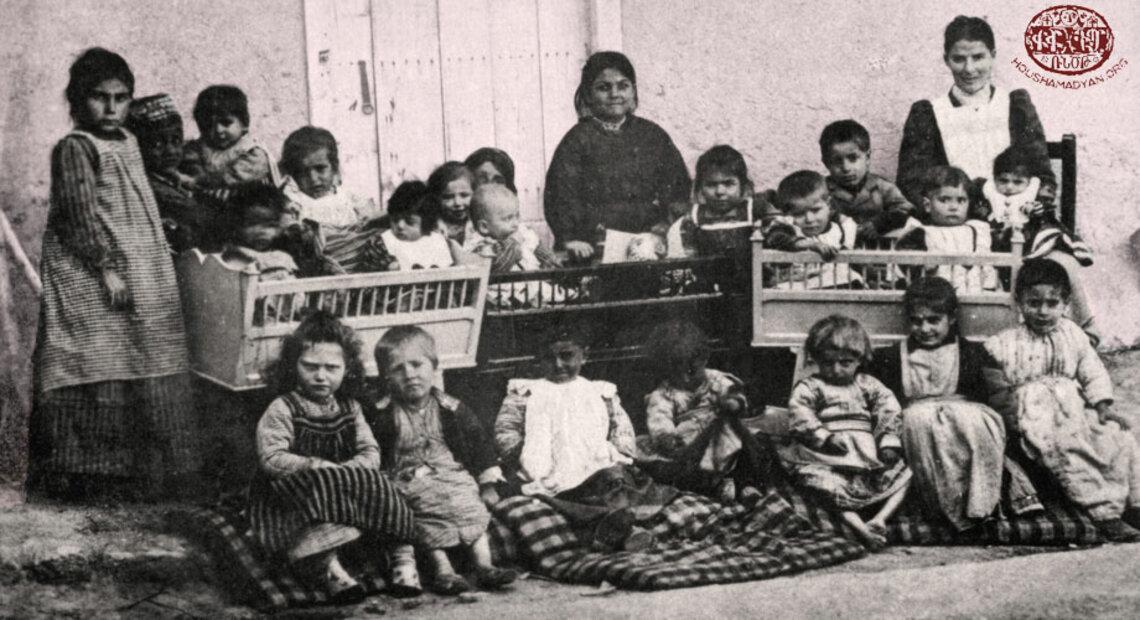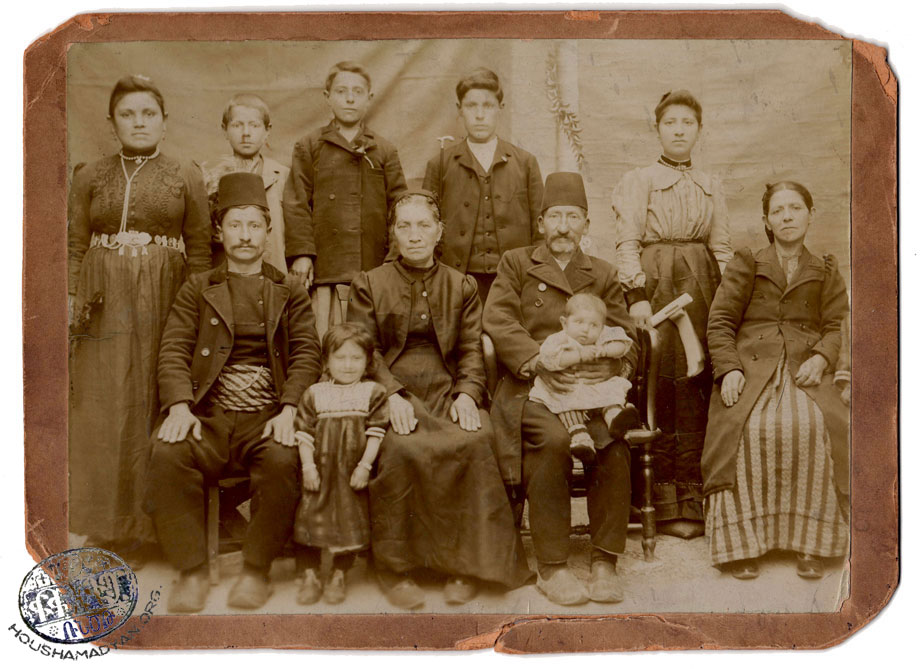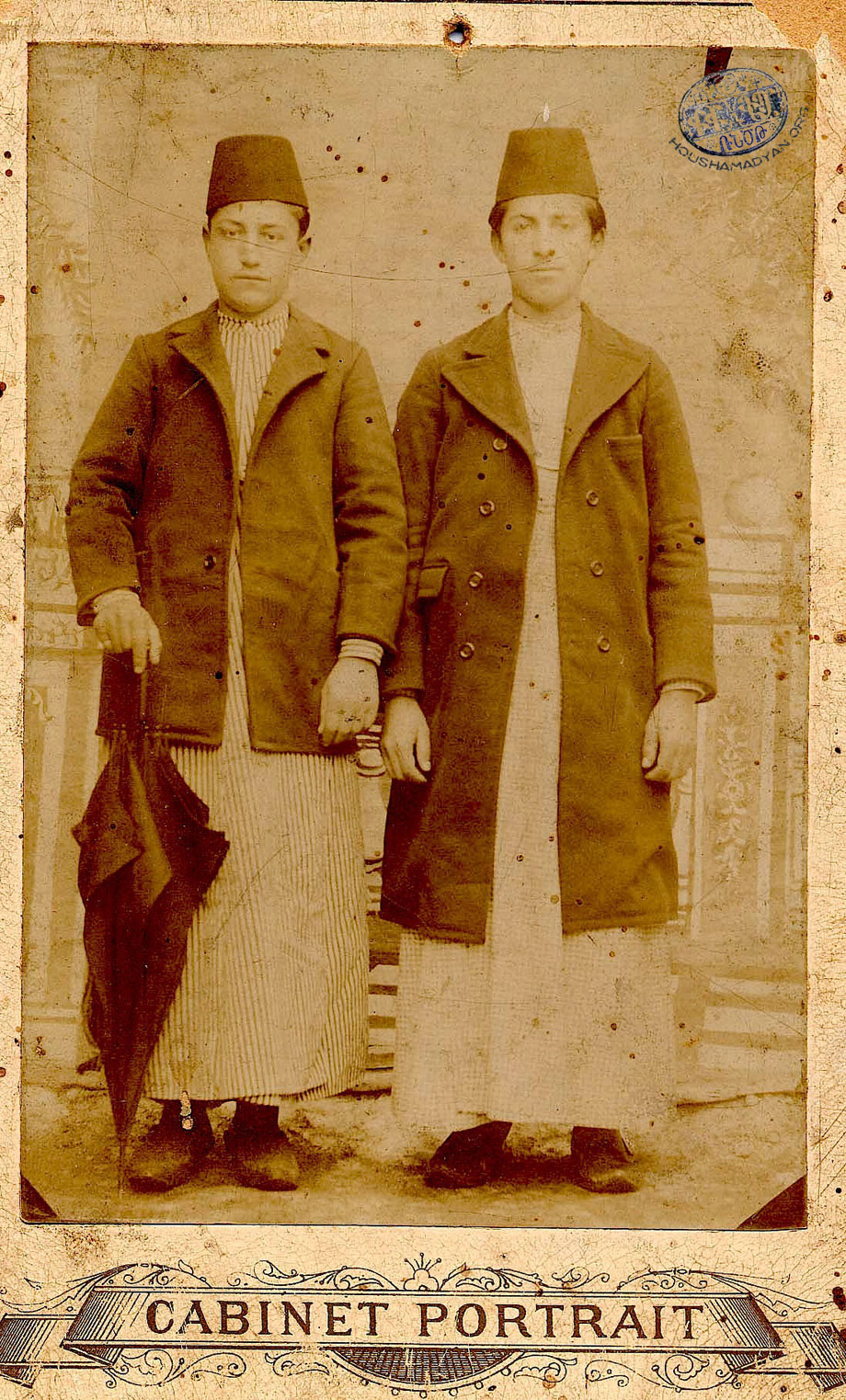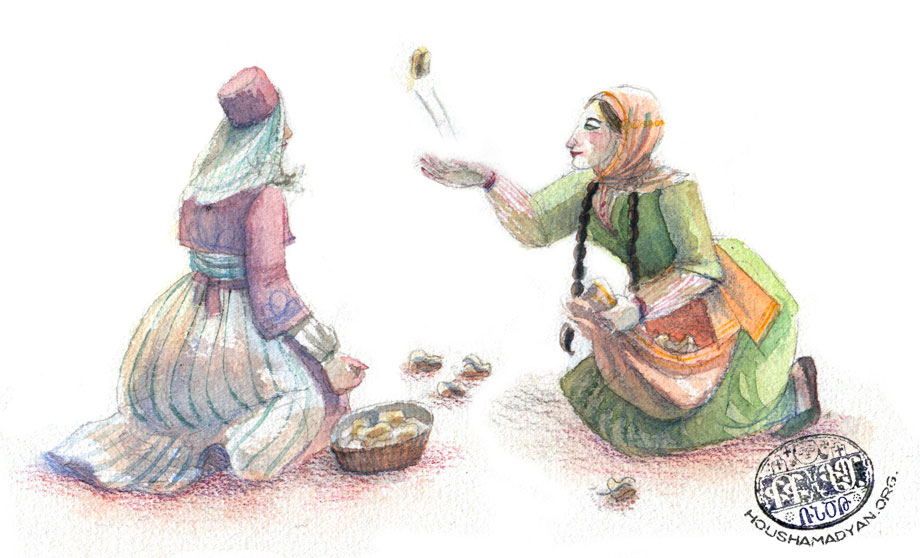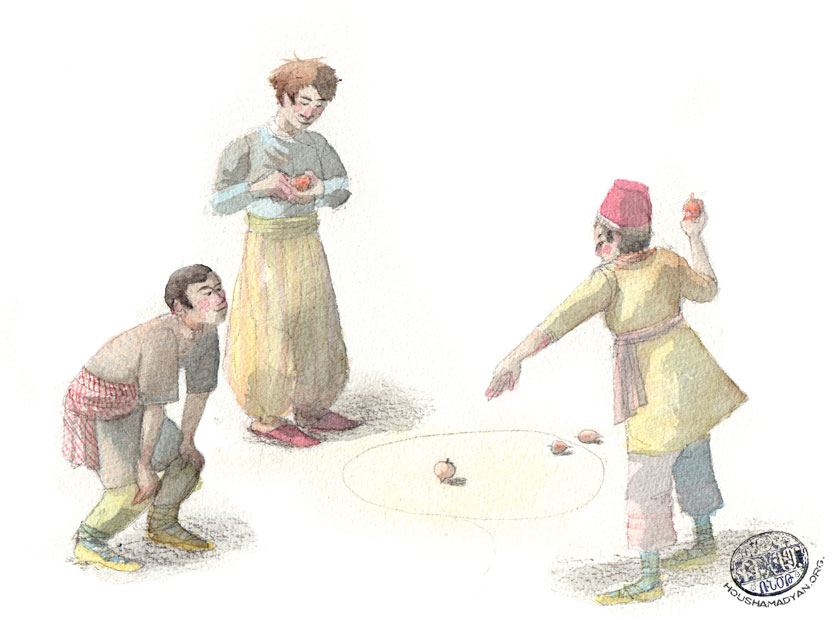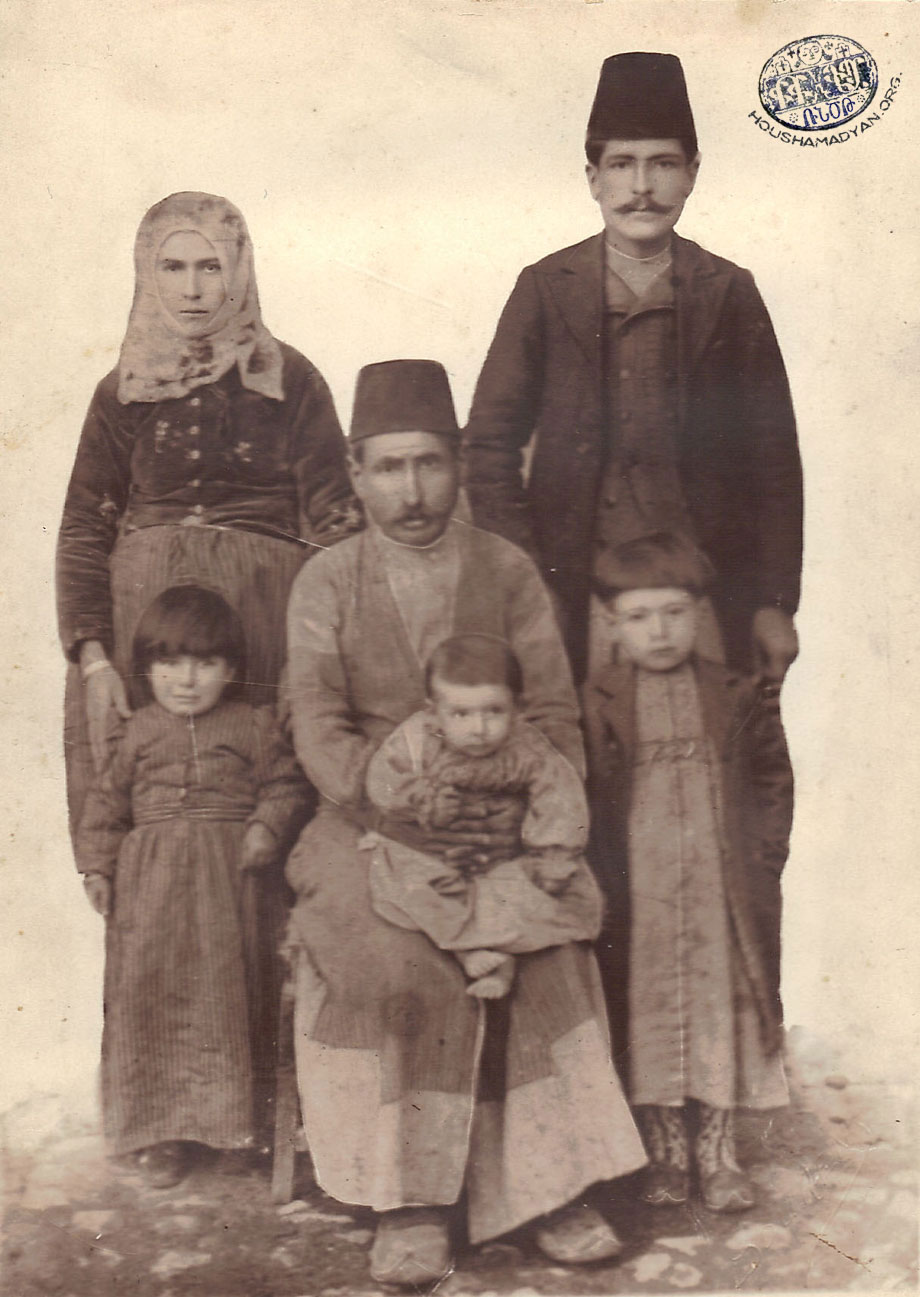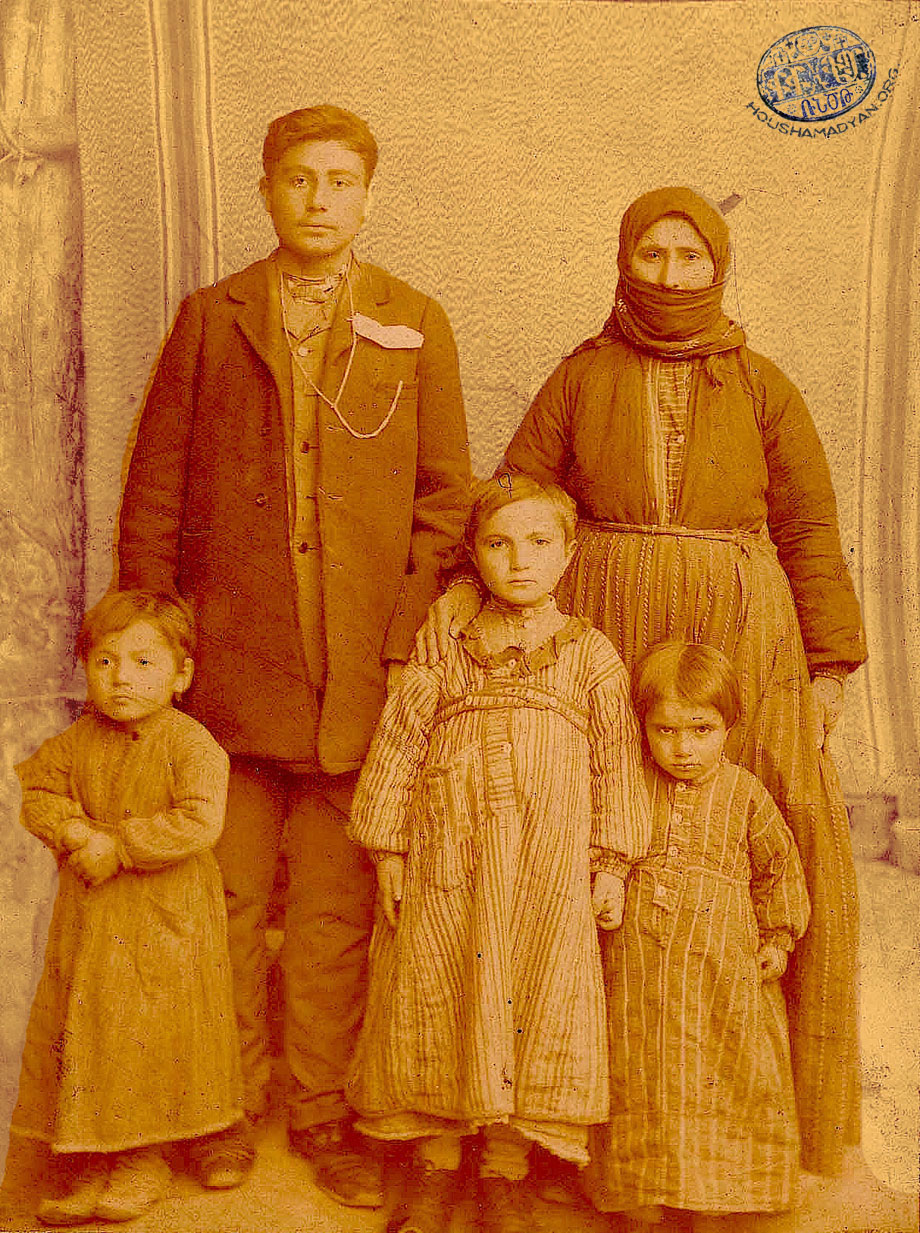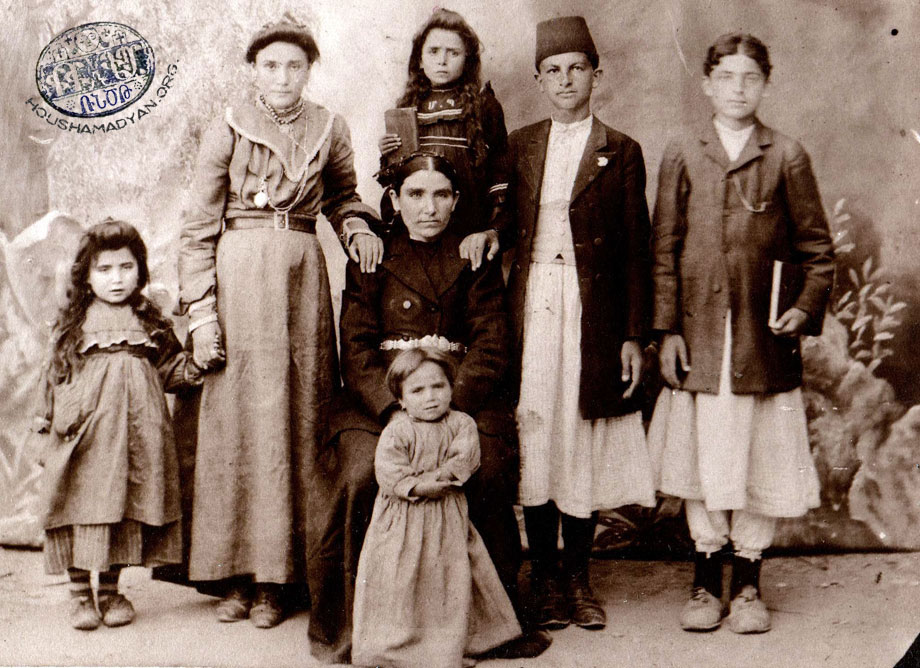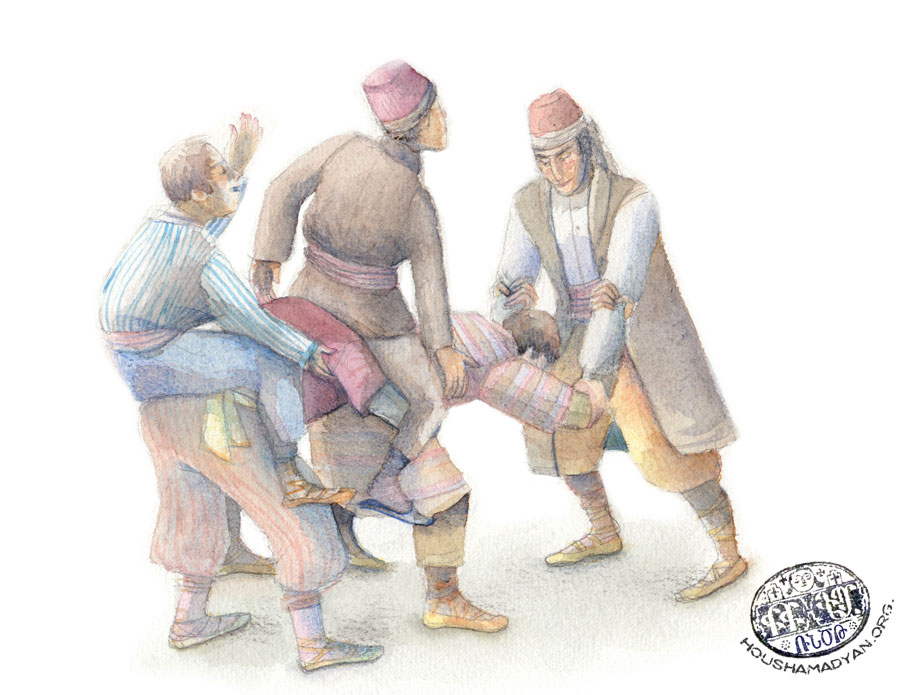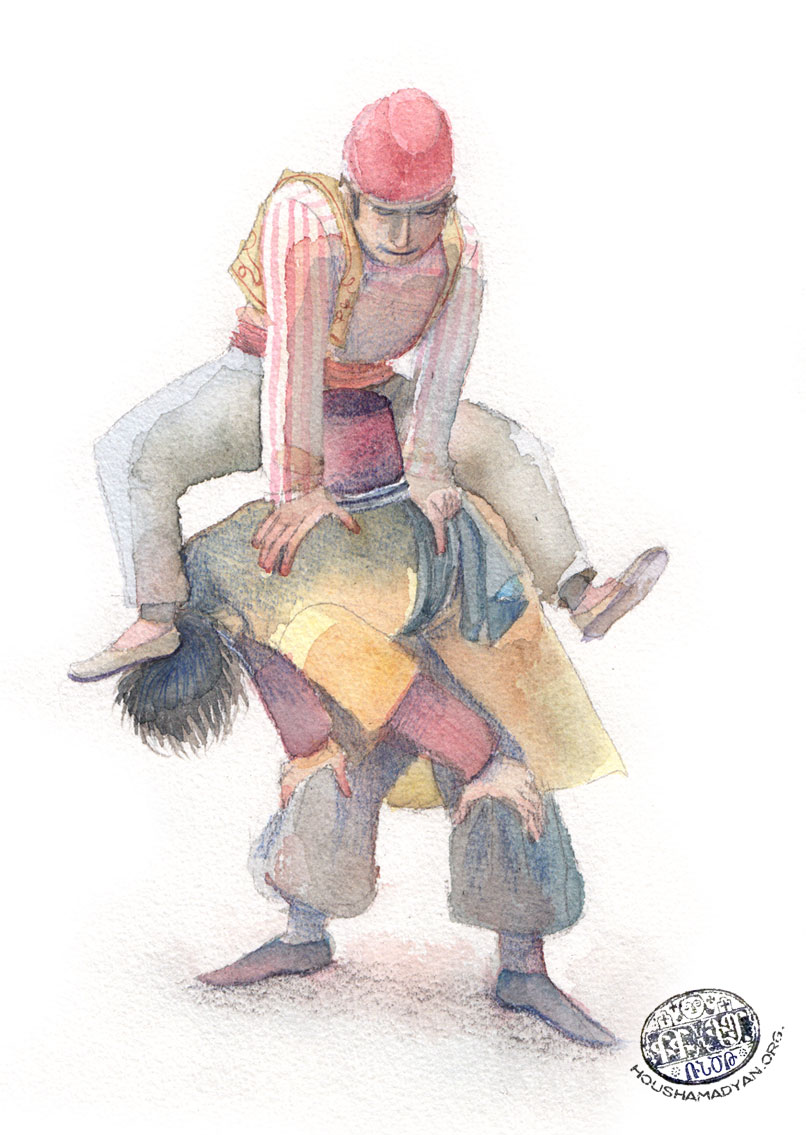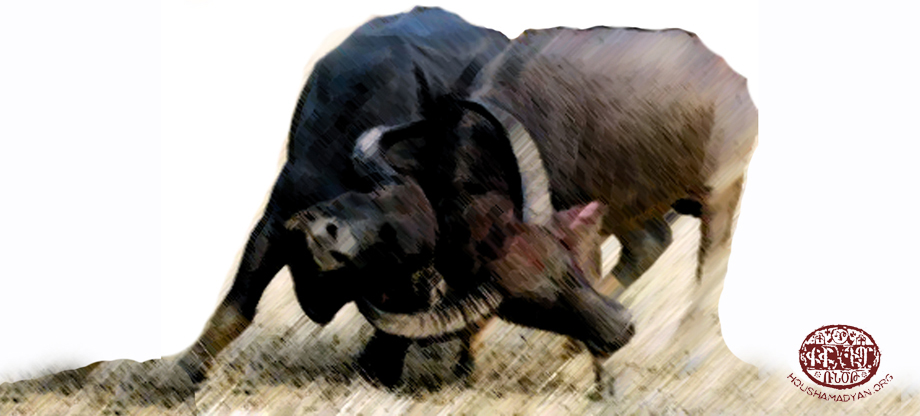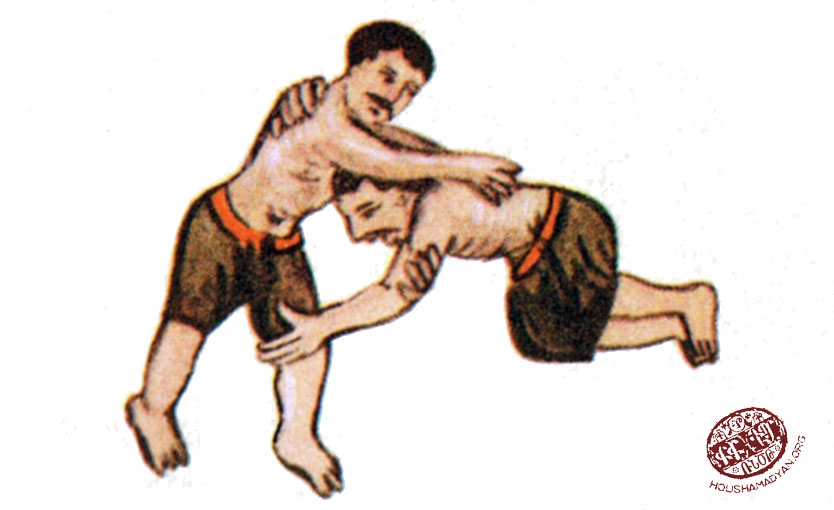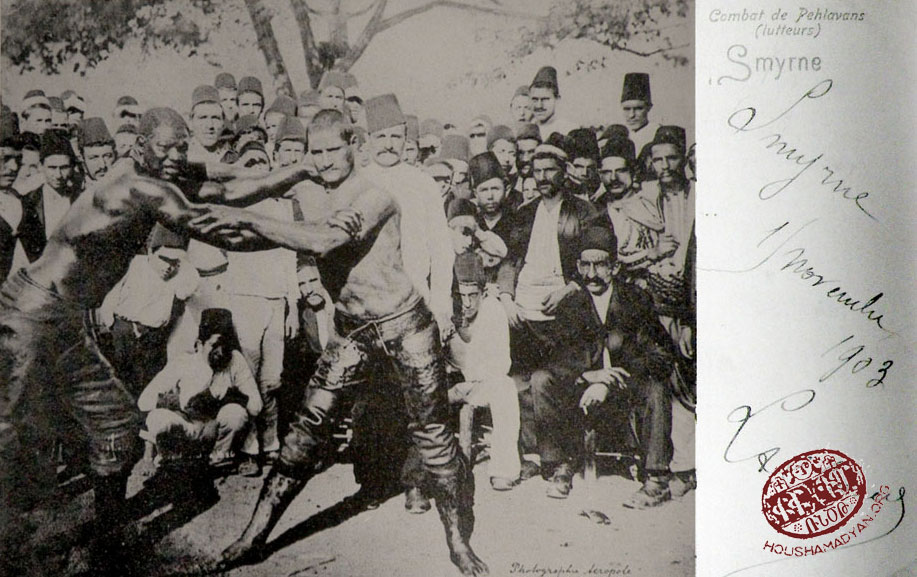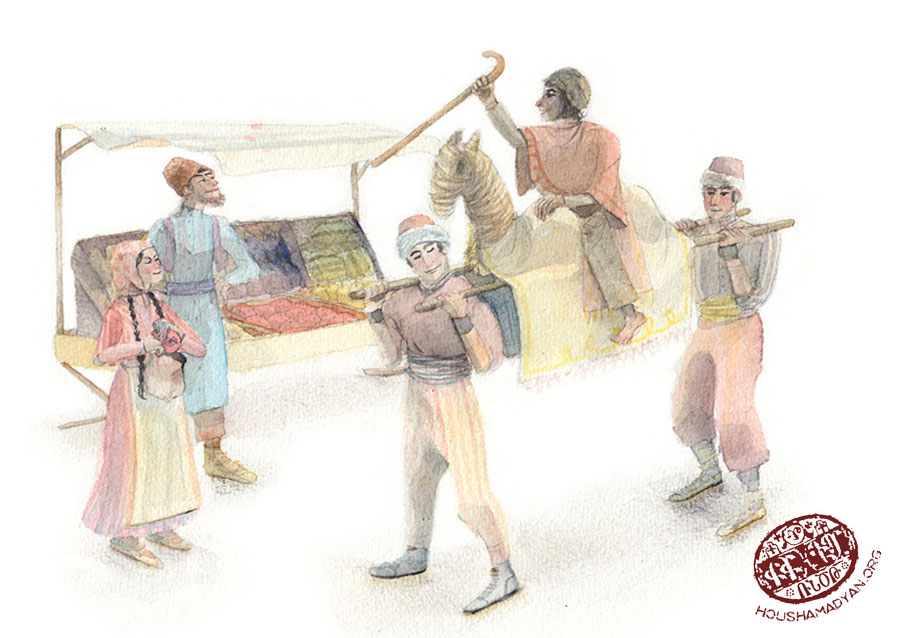Harput – Games
Author: Vahé Tachjian, 12/6/12 (Last modified 12/6/12)- Translator: Ara Melkonian

We can see, through the games played in Harput, various details of the ways that local society lives. In reality with this subject we describe sometimes very simple games, the like of which we can find in the past in many societies all over the world. But this same subject is also an opportunity to examine the more intimate times of the Armenians of the plain of Harput, their minor pleasures and pastimes - things that make the daily life of the Armenian of Harput more understandable - and the ruling social factors there.
It is interesting, for example, to see the abundance of games. They are often played in the villages and have either local dialect or Turkish names. It is possible that this is enough proof to think that such games have existed among the people of Harput from earlier times. It is therefore wrong to think that they have started to be played in local society in the 19th century, with the arrival of western missionaries. Games are often played by boys and girls together, something that is also an interesting expression of local ways of living. Wrestling is also especially notable. In modern-day Turkey this is presented as a national sport and considered to be a real legacy of central Asia. There are many Turkish myths linked to it which emanate from those nationalist sources. We cannot say, concerning the example of wrestling in Harput, that it refutes the above ideals, but at the same time it is also proof of the importance that this sport has in Armenian-inhabited villages. The best demonstration of this is that the Kurdish aghas of Armenian villages organise wrestling matches between the best wrestlers of two different villages, both of whom are Armenians, to settle differences between themselves. The competitions take place with huge crowds, the Kurdish aghas and policemen present.
Many of these games are, however, simple pastimes. Apart from the classic top (hol) and checkers (dama), there are other games which require some explanation. The rich Armenian primary sources available concerning the villages of Harput give us the opportunity to present their various details.
Drawing lots (vidjagnere)
Drawing lots exists with every game. It decides who or which team will start it. Lots are used by the team leaders to elect the members of their team. The most widely used kind is ‘wet-dry’. They choose a flat stone and spit on one side. One of the opposing teams chooses the wet one, the other the dry. The stone is then thrown into the air. When it lands on the ground on the wet side, those who had chosen the dry one win and begin the game. [1] Another method is ‘holding the stone’ (kar-pernug); in other words one of the players takes a small stone and conceals it in one of his hands. If his opponent correctly identifies which hand it is in, then he starts the game. Otherwise the holder starts it. The throwing of knucklebones (vek) - also known as ashugh in local dialect - is also a way of drawing lots. The two sides of a knucklebone are called zil or tam (or sofi). A player gives the name of one of the sides, while the other throws the bone. The look to see which side is uppermost after it lands; if the guess is correct, the person who made it starts the game. [2] Another way that is widely used in the plain of Harput is hakul-hukul. A person stands in the middle of the team and begins to recite the following words:
Hakul hukul,
Chare chambur,
Msge ambar,
Daze duze,
Khalkhan khulandj,
Bandur bandj.
One person is pointed out with each line. When they reach bandur bandj, the person pointed out is the one chosen. [3]
Yeghia Mooradian (left) and Yervant Garabedian (right) from Pazmashen (Bizmişin/Sarıçubuk) village. Photographed in Mezire in 1908. Yeghia is 16 years old in the photograph. He and his brother Tateos (not pictured here) are orphans as a result of the 1895 massacres. Yeghia attends the Euphrates College in Harput, then departs for America (Source: Craig Wallen collection)
Manni beyug (or the coffee cup – findjan – game)
This is played by two competing teams.
12 coffee cups (findjan) and a ring are arranged on a tray.
Lots are drawn to determine which side starts the game.
A member of the team starting the game secretly conceals the ring under one of the coffee cups, and then the whole tray is put before the opposing side. Each member of the opposing side turns over a cup in turn. If the ring appears from under the last cup, then the side turning the cups over is deemed to have lost, losing a point, and the game is repeated. If, however, the ring is found earlier, then the game is won by the side turning the cups and it is their turn to hide the ring.
Those looking for the ring always pay attention to the facial expressions of those who have hidden it. So the latter may use various theatrical movements or false expressions to fool their opponents.
The prize is fixed before the game starts, and can be 3-4 baskets of grapes, half as litre of pears, or a tray of kadayif or paklava.
Manni beyug is played by boys and girls together. [4]
Blind-man’s-buff (achk-gabug)
The person whose eyes are to be covered is determined by playing hakul-hukul. The eyes of the chosen person are firmly covered with a handkerchief and the game begins. The person with their eyes covered has to find and hold one of the others. The person caught then becomes the one to have their eyes covered and the game resumes.
Boys and girls play this game together. [5]

Hide-and-seek (ach-khpug)
This is played in the yards in summer, and in the stables in winter, where there are many hiding places such as mangers and stalls, behind buffaloes and oxen, various places around the olive press, behind the circular press (ding), or under the raised floor that runs along one wall (saku) etc.
The ‘seeker’ is determined by playing hakul-hukul.
The person chosen hides his or her eyes with their hands and leans their head against a post and waits until their friends have hidden themselves. He or she then shouts ‘Have you done?’ – in other words has everyone hidden themselves? They must wait until someone shouts ‘It’s done!’ The ‘seeker’ then opens his or her eyes and begins to look for the others. When they see someone, they shout the person’s name and run to the post that they were originally leaning against and spit on it. The person found then becomes the seeker. If, however, the person found reaches the post first and spits on it, then he or she is free and the original seeker continues to find the others.
Boys and girls play this together. [6]
Stones-game (five-stones, karug-khagh)
Five small stones are essential.
The player puts all five stones in the palm of his hand and scatters them on the ground, so that they are not too far apart, but fairly close together.
The player then chooses one of the stones and keeps it in his hand. The chosen stone is called dada. She then throws it into the air, and swiftly picks up one of the others, so that she catches the dada stone before it falls to the ground. She must not touch or move the other stones that are on the ground when doing this otherwise she is considered to have lost the game and it is her playmate’s turn to play. In this way all the stones have to be collected in the palm of the hand.
Once the player has successfully picked up all her stones, she then repeats the game, but picking up the stones in pairs (2+2). In the third round, she picks three up together and then the fourth (3+1) and in the final, fourth round, all of them at once.
After completing this, the second stage of the game begins. The player creates a bridge with the thumb and index finger of her left hand on the ground. Then she scatters the five stones to the left of the bridge and chooses one which becomes the dada. This she throws up in the air with her right hand, at the same time quickly trying to bring out the stones out from under the bridge, without them touching each other, and catching the dada in the same hand before it falls to the ground. She throws the dada up a second time, at the same time swiftly pushing the stones under the bridge and catches the dada in the same hand before it falls to the ground. The last part of the game is to throw the dada up in the air with the right hand and swiftly pick up all four stones at once with the same hand, catching the dada in it too.
This is generally played by little girls. [7]
Pon-tskoug (khuyelar in Turkish)
This is played by two people.
The person who starts is decided by drawing lots.
10 walnuts are needed for the game (knucklebones or small stones may be used instead of walnuts).
Scoop out a depression in the ground about 15 cm (6 inches) in diameter.
The person starting the game stands seven paces from the depression with the 10 walnuts in one hand and throws them in its direction.
The number of them that have landed in the depression are then counted. If the number is even, the thrower wins. As his prize, he received the same number of walnuts from his opponent. If the number is odd, then the thrower’s opponent wins those in the depression and it is then his turn to throw.
This is played adolescent boys. [8]
Cheghelar
A circle of about 1.5 m (5 feet) radius is drawn on the ground and each player puts one or two knucklebones in the centre.
The players determine a point outside circle from which each one will throw his sakka. This is the bone taken from the hind leg of a mature, fat sheep, and is quite large and weighty. Expert players drill holes in it and fill them with lead.
The knucklebones in the centre of the circle have to be struck by the sakka in such a way that they are thrown out of the circle. The sakka thrower wins each knucklebone he manages to eject from it. His turn continues while his sakka strikes a bone, and passes to the next person when it fails to hit one. [9]
Zil (zillar in Turkish)
This is played by either two people or two teams.
Walnuts and knucklebones (vek) are needed.
A circle is drawn on the ground about 1.3-1.5 m, (about 4-5 feet) in diameter. The diameter line is also drawn.
Each player puts two walnuts next to each other on the line marking the diameter.
The players stand in the centre of the circle near the walnuts and throw their knucklebones forward at the same time. The bones they throw must land outside the circle but as close to its edge as possible. The winner of this first stage in the game is considered to be the one whose knucklebone has landed on the zil side. If more than one of them has fallen on the zil side, then the winner is considered to be the one who owns the one nearest the centre of the circle. The players whose bones fall on the tam side are automatically considered to have been beaten and lose their turn. If all the thrown bones fall on the tam side, then the winner is considered the person whose bone is nearest the centre.
The order of play of the second part of the game is as follows: (a) the owner of the bone that has fallen zil side down nearest the centre of the circle; (b) then the owner of the second nearest, then the third and so on; (c) the owner of the bone that has landed tam side down nearest the centre of the circle; (d) then the owner of the second nearest, then the third and so on.
The Der-Manuelian family from Ichme/Içme village, plain of Harput, ca 1907. The children, left to right: Sara (born 1904), Haygag (born 1906, on his grandfather’s lap), Yeghia (born 1902). Standing: Haygag (father), Marta (mother). Seated, Hovhannes (Chamich Amu, grandfather) (Source: Ara Jingirian and Hourig Zakarian collection)
The first player stands at the point where his bone landed, picks it up and throws it towards the walnuts on the diameter line, trying to hit them and by doing so eject them from the circle. If he succeeds, then not only does he win the nut that has landed outside the circle, but the game also resumes from the point where the thrown bone has landed. His turn continues if his bone falls on the zil side, even if he fails to get the walnuts out of the circle. If, however his bone falls on the tam side, then it becomes the next person’s turn.
The game continues until all the nuts are removed from inside the circle.
This game is played by adolescent boys. [10]
This same game has a simpler variant. A line is drawn on the ground. Each player places his bone on it. The first player stands just behind the line of bones and throws his sakka (the bone taken from the hind leg of a mature, fat sheep) several paces forward, while at the same time shouting ‘ashughs zil mi?’ (has it landed on its zil side?). If the sakka falls successfully on its zil side, then the thrower wins all the bones. If it falls on its tam side, it is the second player’s turn. If all the players’ sakkas fall on their tam sides, then they all throw them again, taking turns in the same order. Each struck knucklebone is a win. [11]
Mstebab
This game is played by two players.
The players sit facing each other. Each places two veks on the ground such that one touches the back of the other.
They decide who starts using the ‘wet-dry’ stone method. The one who starts takes up his sakka and strikes the veks with the object of turning them over. He wins all of them that are. His opponent then plays, with the same object, and they continue turn and turn about. [12]

Tellar
A tellar is a small round stone like a marble. It is also called a giulla. Either walnuts or veks are used for this game, arranged about one pace apart along a line drawn on the ground. A position is determined, at the end of the line, from which the tellar will be thrown. The targets are the walnuts or veks. The person who strikes the target nut or bone wins it. [13]
The gdur (roof or house) game
This is played by two competing teams, each consisting of about ten older girls and young married women.
One team, holding hands, pursues a member of the opposite team. They must capture her by surrounding her and holding her in this human roof or house. The captured girls’ team members must try to rescue her by splittin open the barrier of girls holding her in. [14]
Chanch
This game is played by two competing teams.
A small depression is opened in the ground. The chanch, bridge-shaped piece of wood with sharp ends and about the size of a palm, is settled over it. One of the teams throws the chanch, the other catches it. A member of the throwing team, holding the end of a stick about 1m (3 feet) long, inserts the other end into the pit, under the chanch. Then the chanch is thrown upwards using a strong thrust of the long stick. The catching side stand at a distance opposite the thrower. Holding their skirts wide, they wait for the chanch to descend. If one of them manages to catch it in their skirt, their team wins, and it is then their turn to play.
This is played by adolescent girls and young married women. [15]
Tail-holding (boch-pernug)
‘Mother’ and ‘chick’ are decided by using the ‘stone-holding’ way of drawing lots. The person playing the ‘chick’ squats down, while the ‘mother’, holding on to the end of the ‘chick’s’ belt or the hem of the zebun (long dress or coat), in other words the ‘tail’, turns around it.
The other players surround the ‘mother and chick’ and try to hit both. The ‘mother’ has to try to kick those surrounding her, without however letting go of the ‘tail’. The first person to receive a kick by the ‘mother’ becomes the ‘chick’, while the chick takes the ‘mother’s’ place.
Adolescent boys and girls play this as a team. [16]
The Avedian family, Mezire, ca 1910. The young girl standing in the centre, holding a book is Parantsig/Victoria (1902-1973, father’s name Hagop). Seated immediately in front of her is her mother, Varter Avedian. Standing on Parantsig’s left is her elder sister Garine, who is a graduate of the Harput Central School (Source: Lance Kasparian collection)
Aylekh tsekug
The first aylekh tsik (player with the handkerchief) is decided by using the ‘stone-holding’ way of drawing lots.
The other players squat down in a circle with their backs outwards and their faces inwards.
The chosen player (the aylekh tsik), with a handkerchief in his or her hand, begins to circle those squatting. He or she finally chooses the target person and secretly puts the handkerchief behind them. The chosen player circles the others once more and if the target person still hasn’t noticed the handkerchief behind them, he or she grabs the target person and climbs onto their back. The circling player is then considered to be the victor and squats in the target’s place; the target person becomes the new aylekh tsik. It can, however, happen that the person receiving the handkerchief notices what has happened; he or she then immediately gets up and runs after the aylekh tsik, attempting to grab him or her before the latter takes his or her place in the circle. If he or she is successful, the pursuer gets on to the aylekh tsik’s back, then returns to his or her place in the circle and the original aylekh tsik continues in his or her role.
This game is played by a team of adolescent boys and girls. [17]
There is another version of this game, called tulla. The latter is a belt, one end of which is tied in a knot. The players squat in circle in the same way. The only difference in the game is the use of the tulla. The person circling the others hits the target person unexpectedly, who gets up immediately, chases the striker with the object of touching them. This pursuit is made in a circle. The striker has to try to take the target’s place before being touched. [18]

The chul game
This game is played by two competing teams.
It is played either on the roof or in a yard with a level floor, as the play area must be greater than 15-20 square feet (1.4-1.8 sq m). A diagonal line is drawn across one corner of the play area: this becomes the pon (nest).
First the team leaders choose their teams by using the ‘stone-holding’ way of drawing lots. The same method is used to determine which team enters the pon, in other words must remain in the area behind the diagonal line. The other team remains outside it. The first player comes out of the pon and, hopping on one leg, begins to chase the members of the other team. Only one ‘chaser’ can play at a time. When he succeeds in touching someone in the opposing team, then that person becomes a tes and retires. If however, the hopping ‘chaser’ puts his raised foot on the ground, he becomes a tes and stops playing.
This game is usually played by young men.
In the village of Parchandj Gelen Arut, Mghdesi Asadurents Manug, Mghdesi Kapoyents Boghos, Chortutents Bedros, Kilardjonts Krikor, Minasents Krikor and Dzeronts manug are superb ‘chasers’. [19]
Tiz-Borkug
Two people are drawn by lot to play, and must sit on the ground opposite one another, with their legs extended and the soles of their feet pressed together. The other players take it in turns to jump three times over their legs. On the fourth occasion, the barrier is raised by one of the seated players by raising one leg and putting the heel of that foot on the toes of that of his companion. The other team continues to jump. On the next turn, one of the seated players raises the barrier still further by putting the heel of his foot on the toes of the raised one. Finally the fourth foot is added. The people jumping must not touch the raised legs. If a player does, then he sits down, replacing the previously seated player, who then joins those who are jumping.
This game is played by young men. [20]

Zarazamba
This is a team game.
The zarazamba, which in this instance is the name of the player, is chosen by the hakul-hukul method.
A stake is driven into the ground, to which a 10 feet (3m) long rope is tied. The zarazamba keeps hold of the end of the rope and circles round the post. Each of the other players removes his belt and, having tied one end into a knot, throws it near the stake. These kinds of knotted belts, as we have seen, are called tulla.
The free (outside) players have to try to lay their hands on the tullas. The zarazamba, always retaining his grip on the rope, has to protect the tullas. He can only hit an approaching player with his feet. The person hit then becomes the zarazamba. If, however, the free (outside) players manage to get a tulla without getting hit, he then has the right to hit the zarazamba with that same belt. All the blows must be below head height. If someone hits the zarazamba’s head, then he becomes the zarazamba as a punishment.
This game is played by young men. [21]
Pad-kashug
This is a game for two players.
The two players must sit on the ground opposite one another, with their legs extended and the soles of their feet pressed together. Both of them hold on to a stout stick about 1 inch (5 cm) and 2-2.5 feet (60-75 cm) long. The game begins with each player trying to pull the stick his way. The winner is the one who finally gets the stick.
This game is played by young men. [22]

Stone throwing (kar nedug)
This is a team game.
The game consists of throwing a large stone with one or two hands as far as possible. A place is selected from where the stone will be thrown. The game is played in four different ways.
- The stone is thrown with both hands. The feet may be moved at will.
- The stone is thrown with both hands. The feet may not be moved. The stone thrown with both hands is the heaviest. It may weigh up to 110-130 lb (50-60 kg).
- The stone in held one hand and raised to head height then thrown taking a step forward.
- Turning and throwing the stone with both hands between the legs.
The winner is the person who throws the stone furthest. The people in Parchandj village who have made a name for themselves playing this game are Herko Giragos, Guyr (Blind) Agop, Rev (Badveli) Bedros, Gelen Arut and Kilardjonts Khacho.The game is played by young men. [23]
Taking the fire (grag arnug)
This game is played by two competing teams.
This is a game played during feast days such as Easter. It takes place on an open field. Each team has its ‘house’, in which it keeps its ‘fire’. None of the books on Harput describe what this fire actually looks like. It is probably just some object.
The defending team protects its ‘house’, while the opposing one tries to enter it to steal the ‘fire’. The defenders carry tullas. The person who steals the ‘fire’ immediately rushes back to his team’s ‘house’. But one member of the defending team has the right to pursue the ‘thief’. He must run fast, catching up with the ‘thief’ before he enters the ‘house’. If he succeeds, then he can give the ‘thief’ a good beating with his tulla, right up until the time he enters his ‘house’. The former defenders then become the attackers, trying to steal the ‘fire’ in their turn.
This game is usually played during festivals by newly-married men and those who are engaged to be married. [24]
Ambaresh or ambarosh
This game is played by two competing teams, each of 4-5 players. The team to start is chosen by the ‘wet-dry’ stone method.
The team that loses the toss of the stone forms a line of bent backs and heads. This is done as follows. Only the first member of the team doesn’t bend down, but stands erect with his back to a wall. The second player bends down and puts his head in the erect player’s stomach, using it as a support. The standing player holds him firmly by the shoulders, so that the chain of backs is firm. The third player also bends down and puts his left shoulder against the rear of the second player, gripping him tightly around the hips with the left arm. The fourth player (and possibly the fifth) does the same. Thus a straight line or chain of four or five players is formed.
The other team begins the game. From about ten paces distant the first player runs towards the rear of the chain and throws himself onto it, hoping to get as far forward from the end as possible, without falling off. He immediately begins to count to 20, 50 or 100, as previously agreed. His three or four team-mates do the same, also counting as they land on the backs of their opponents. If any one of the people who jumped on either falls off or touches the ground with his foot, the team loses and changes places with the other.
This game is played by young men. [25]
The stable game (akhor khaghal)
This game is played by two competing teams.
It is usually played at the beginning of spring, in dung hollows. The members of the teams are determined by drawing lots.
One team enters the ‘stable’, in other words the hollow area. The team outside the area waits, about 5 paces distant. A member of this team has a ball made of linen cloth or string in his hand and circles the ‘stable’, always keeping his distance. He carefully monitors the movements of the ‘inside’ team. The object of the game is to hit an opponent with the ball. However it is best to throw the ball suddenly, so that the thrower has a chance to escape, otherwise those inside can pick the ball up and throw it, trying to hit the thrower as he makes his escape. If they do, they’ve won and the team ‘outside’ enters the ‘stable’ in their place. [26]
Passing over (verayen antsug)
A player is chosen who bends over, lowers his head, opens his legs and holds one of his knees with each hand. An old hat or handkerchief is placed on the player’s back. The other players have to vault over the first one’s back. The trick is to jump over without disturbing the hat or handkerchief; whoever does then becomes the person to bend down. [27]
Gor-gor
This is a team game.
In the first instance the person who is to be the ‘brooding hen’ (a hen sitting on eggs) is decided. In one hand he holds a whip made of string or linen cloth knotted at the end. In the other he holds a length of thin string, with which he makes eye-shaped loops. The latter are riddles aimed at the other players in the team who are gathered around him. Every time he creates one, he asks, ‘What is this the eye of?’
The person giving the correct answer swiftly takes the whip from the ‘brooding hen’ and begins to hit those about him with it. The whipping has to stop immediately the ‘brooding hen’ shouts ‘Gor-Gor.’ If the person wielding the whip is slow in returning it to its owner, then the others have the right to hit him. [28]
Khalayva
This is played by two competing teams.
Teams of equal numbers (between 5 and 10 players) are formed. The team leaders choose the members of their teams. The first ‘chooser’ is determined by the ‘stone-holding’ method. The team members are then chosen alternately in turn by the team leaders.
Each team takes up a position on a particular spot which is called khala (castle). There must be about 50-60 paces distance between them.
The attacking team is chosen by using the ‘wet-dry stone’ method.
The attacking team chooses its advance guard, who is preferably a swift runner. He first goes towards the opposing khala, thus starting the game; he then tries to get back to his own team’s castle. But the opposing team sends out one or more pursuers. Their aim is to touch the advance guard, thus preventing him from entering the khala. At the same time those in pursuit have to be very careful, as the pursued advance guard’s team members have the right to hit them and bring them into the khala as prisoners.
It is enough for one of the pursuers to touch the advance guard to have him considered to have been removed from the game. In that case the same team sends a new advanced guard. If he does succeed in entering his khala, then it is the opposing team’s turn to despatch an advance guard. The game continues until one khala is emptied.
This game is played by men. [29]

Khabakh
It is also called the ‘castle game’, and is played by two competing teams.
Teams of equal numbers (between 5 and 10 players) are formed. The team leaders choose the members of their teams. The first selector is determined by the ‘stone-holding’ method. The team members are chosen alternately in turn by the team leaders.
A flat stone is placed in the middle of the field of play. This represents the castle. One of the teams becomes the castle defenders, the other the attackers.
The defending team is chosen by using the ‘wet-dry stone’ method.
The defenders gather around the flat stone, which they have to protect against the other team’s attacks. They also make sudden forays on the attacking team, trying to touch them, making them tes – in other words to put them out of the game. But they take care never to venture far from the ‘castle’, because the attackers could capture it.
How is the castle captured? If one of the attacking team touches the flat stone without being struck by the defenders, the castle is considered to be captured. The attackers can’t make a defender tes – out of the game. They can only try to make them djer, in other words to get them away from the stone and capture the castle.
The best way for the attackers to capture the castle is to launch pairs of attacks from various directions, so as to make the defenders as confused as possible. So, while one of the attackers approaches the castle and tries to get the defenders to concentrate on him, at the same time one of his team-mates tries to touch the flat stone.
It is sufficient to touch the stone with a hand or foot to capture the castle. When they succeed, the captor shouts, ‘Khabakh!’ [30]

To strike a melon, or to pull a melon
Harput melons are striped green and white. They are harvested during the summer and piled up in cool places to be sold.
When this happens, all the young men of the village gather to play ‘pull a melon’. Two people decide on a melon, and gambling takes place with the following questions:
‘Is the seed red or black?’
‘Is the seed yellow or orange (in local dialect kamoni)?’
‘How many seeds are there in this slice (in local dialect (shakhkha)?’
‘How many okhas (in local dialect hokhkha, oka, 1.28 kg or 3 lb) does this melon weigh?’
Then the melon holder cuts it open with his chakhu (knife). The person who guessed the answers correctly wins the melon, while the loser pays the gardener its cost. In the case of the number of seeds or the weight of the melon, the person closest to the actual figures is the winner. Sometimes the prize is determined to be up to 10 melons. [31]
Buffalo fighting (komeshamard)
Buffalo fighting is a great spectacle in some Harput villages, taking place on feast days such as Easter and Paregentan. The strongest and biggest animals are sought for this game, and are often called by Harput pet-names given to such animals like Tosun, Arab, Toroman, Aslan, Boro, Bashsho, Khumash and Tikko.
The animals reserved for fighting are given extra care by the village. As food (in local dialect alig) they are given kusha (lathyrus tuberosus), govdun and gruel. They are given the best quality cold water from the fountains and streams. They bathe in those waters too. In other words there is a concerted effort by the villagers to keep these animals well and strong as a prelude to the day of the fight.
The buffalo fight takes place in the village’s chay. This is the place opened by the spring rains, and is usually a wide area. The two competing buffaloes are brought to the site, led by ropes, and where the entire population of the village, with its mayor, overlord and bey. The lead ropes are removed and the two animals appear opposite one another, ready for a wild fight. The fight begins, head to head, horn to horn, while the animals butt each other, all to the cheers and shouts of the onlookers. The villagers too are divided into two camps, each backing one of the buffaloes. Some of the onlookers place bets, with the winner getting, say, a sack of wheat. The defeated buffalo either falls to the ground or simply runs away. In the latter event, the winning buffalo usually chases the defeated one as far as the stable door. It is only here that the villagers stop the contest; they isolate the victorious animal with ropes, and then take it to its stable with great ceremony. [32]
Holding gulesh (güreş, wrestling)
A scene from Armenian miniature painting showing wrestlers (Source: Astghik Gevorkian, The Crafts and mode of life in Armenian miniatures [in Armenian], Yerevan, 1978)
This form of exercise is as popular as buffalo fighting. In the villages it takes place in the chay or any field. Vast crowds of both men and women are present.
It is said that in 1875 the Kurdish aghas of two villages in the plain of Harput – Pazmashen and Tadem (Tadım) – had an argument as to which village had the best wrestler (pehlivan). It was therefore decided to hold a duel between the best athlete from each village. The Sara aghas of Pazmashen told the noted village wrestler Ohan to be ready for the duel. It took place in April in a field between Tadem and Mezire. Abdal Boghosian was a witness to the event and recalls it in his book. Thus, on the appointed day, the village of Pazmashen is in holiday mood. The whole village assembles in St Zakaria Valley, drums and pipes heighten everyone’s enthusiasm, and horse racing also takes place. Then Pehlivan Ohan arrives on his horse, to the people’s wild expressions of applause. The hero of Pazmashen goes to the competition site, with his entire village following. The hero of Tadem likewise, with drums and pipes and his villagers, has set out for the field. Policemen are also present to prevent any incidents. The two wrestlers stand in the field, circle each other several times, approach one another and try each other’s weight; then they circle once more, making the atmosphere even more electric. Then the contest begins, with the first round lasting 15 minutes. The battle resumes after a short break. After battling for 20 minutes, the hero of Tadem falls, the Sara aghas immediately declare Pehlivan Ohan the winner, and the contest ends. The following year Pehlivan Ohan goes to Cilicia as an emigrant worker. There too he becomes a famous wrestler, and Boghosian once more provides various details about him. [33]
Famous wrestlers from Parchandj are Misakents Donabed, Khodjig Mghdesi Marsub, Misakents Bedo, Dengoz (Herko Badji’s husband), Herko Giragos (Dengoz’s son), Hodo Mghdesi Khacho, Goshgar Miosakents Khacho, Khodji Krikor’s son Mardiros and Gelenents Arut. [34] Kharadonayents Don Amu is a well-known wrestler from Tadem. [35] The wrestlers who are famous in Pazmashen are Rev Kaprelents Ohan, Yezgants Khacho, Bedoyents Giragos, Berber Khacho, Bedoyents Kevamun, Choboyents Dono, Arko Khacho, Hazarkhanents Ovagim and Muradents Kevo. [36]
Deve-oyunu (the camel game)
A comic game played on Paregentan days.
Two burly men each have, on their shoulders, the model of a camel made of cloth and rags, on whose back the camel driver is seated, also dressed in rags, face blackened and carrying a long and muddy rod. They are preceded by a youth, likewise dressed in rags and his face blackened, holding the camel’s reins. The camel is taken through the streets of the village, led by drums and pipes, while the camel drivers entertain the people even more with jokes. Thus, for example, the procession stops in front of the butcher’s or grocer’s shop, the camel driver extends his rod towards the meat that is hanging there or the various items that are displayed in front of the grocer’s shop, and says, ‘A khaburgha with a tail weighing three okas,’ (irek hokhkhanots bochov khaburgha me) or ‘ An oka of red raisins,’ (hokhkha me garmir chamich). Then he adds, ‘If not, I’ll make everything dirty, ha!’ (Che ne, inch vor ga chamur ginim, ha!). He gets the item and continues on his way. The camel driver is also offered wine on his journey; he descends from the camel’s back and dances. Both old and young follow the camel’s procession with great enjoyment. [37]
To play paylivan (trapeze)
The paylivan (pehlivan, in this case trapeze artist) generally arrive in the plain of Harput from Mush, after the work in the fields has ended; in other words when the villager, having just completed the year’s heaviest work, has the need for relaxation and enjoyment. They are made up of teams of 4-5 people, who come with their donkeys, on which they have loaded all the various things and the small drums they need. The pehlivans are, at the same time, musicians, and always have kamanchas hanging from their necks. They fix their tightrope where they perform, then wander through the village streets playing their kamanchas and drums, inviting the populace to watch them perform. The whole village assembles and it begins. The first pehlivan jumps on to the tightrope saying, ‘Ya Surp Garabed’. He is barefoot and has a long, thin pole in his hands. He jumps on the rope, hops on it, hangs from it and runs along it, shouting ‘Ya Surp Garabed’ at every major movement. Sometimes he will balance a tray on the rope and, managing to sit on it, slowly slides down the rope. While one pehlivan performs on the tightrope, the others make the atmosphere even more enthusiastic by playing their kamanchas and drums. Entrance fees are not demanded, but they go through the crowd after the performance and collect their reward. Apart from money, the villagers also give them fresh bread, wheat, cracked wheat, de-husked wheat and barley for their donkeys. [38]

Editor's note
Do you know other games played in the plain of Harput, how they were played and their rules? Do you have additions or objections to the information contained in this article?
You can send your explanations or information to our address: houshamadyan@gmail.com
It is imperative that you give us your name, surname and the source of your information in your letter.

- [1] Manug B. Dzeron, Complete history of Parchandj village (1600-1937), Boston, 1938, p. 152 (In Armenian); Hagop Gharib Shahbazian, Our Tankaran village and its bloody love flower beds, France, 1967, p. 42 (In Armenian)
- [2] Dzeron, Complete history…, p. 130.
- [3] Ibid, p. 153.
- [4] Ibid, pp. 152-153.
- [5] Ibid, p. 153.
- [6] Ibid.
- [7] Ibid.
- [8] Ibid, p. 154.
- [9] Shahbazian, Our Tankaran village..., p. 44.
- [10] Dzeron, Complete history…, p. 154.
- [11] Shahbazian, Our Tankaran village..., p. 45.
- [12] Ibid.
- [13] Ibid.
- [14] Ibid, p. 46.
- [15] Ibid, p. 47.
- [16] Dzeron, Complete history…, pp. 154-155.
- [17] Ibid, p. 155.
- [18] Shahbazian, Our Tankaran village..., p. 44.
- [19] Dzeron, Complete history…, p. 155.
- [20] Ibid, p. 155.
- [21] Ibid.
- [22] Ibid, p. 156.
- [23] Ibid, p. 156; Shahbazian, Our Tankaran village..., p. 42.
- [24] Abdal Coledj Boghosian, Comprehensive history of Pazmashen, ‘Baikar’ Boston, 1930, p. 89. (In Armenian)
- [25] Shahbazian, Our Tankaran village..., pp. 42-43; History of Habus village, ‘Baikar’, 1963, p. 65. (In Armenian)
- [26] Shahbazian, Our Tankaran village..., pp. 41-42։
- [27] History of Habus village…, p. 65.
- [28] Shahbazian, Our Tankaran village..., p. 43.
- [29] Dzeron, Complete history…, p. 156.
- [30] Ibid, pp. 156-157.
- [31] Ibid, p. 157.
- [32] Ibid, pp. 157-158.
- [33] Boghosian, Comprehensive history…, pp. 64-66.
- [34] Dzeron, Complete history…, p. 158.
- [35] Shahbazian, Our Tankaran village..., pp. 38-39.
- [36] Boghosian, Comprehensive history…, p. 64.
- [37] Dzeron, Complete history…, p. 158.
- [38] Ibid, p. 159.
